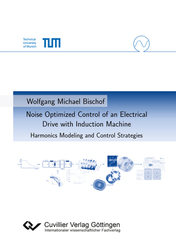| Fachbereiche | |
|---|---|
| Buchreihen (96) |
1378
|
| Nachhaltigkeit |
3
|
| Gesundheitswesen |
1
|
| Geisteswissenschaften |
2364
|
| Naturwissenschaften |
5406
|
| Ingenieurwissenschaften |
1792
|
| Allgemeine Ingenieurwissenschaften | 292 |
| Maschinenbau und Verfahrenstechnik | 862 |
| Elektrotechnik | 686 |
| Bergbau- und Hüttenwesen | 30 |
| Architektur und Bauwesen | 75 |
| Allgemein |
98
|
|
Leitlinien Unfallchirurgie
5. Auflage bestellen |
|
Erweiterte Suche
Noise Optimized Control of an Electrical Drive with Induction Machine
Harmonics Modeling and Control Strategies
Wolfgang Bischof (Autor)Vorschau
Inhaltsverzeichnis, PDF (59 KB)
Leseprobe, PDF (1,6 MB)
This work proposes methods for modeling the acoustic behavior of induction machines as well as optimization approaches for the control of the acoustic behavior. The aim of this work is to simplify and improve the quality of the acoustic modeling of induction machines and to show possible optimization measures in order to make the application and its understanding accessible to a broader group of users. In this work, approaches for the efficient modeling of harmonic phenomena in the electromagnetics of induction machines are shown and analyzed. This work focuses on the development of efficient geometric models for the calculation of electromagnetics of induction machines, which are substantially based on analytical equations and are used in an extended simulation via numerical methods. Subsequently, a method for the acoustic calculation of the vibrations resulting from the electromagnetic force excitation on the surface of the housing of the electrical machine is presented. The approach for the calculation of the surface vibrations is based on the system simulation and the vibration synthesis approach. The presented method offers the possibility to present extensive and realistic models and can therefore contribute to the optimized design of induction machines and many other types of electric drive systems. The procedure consists of a two-stage process, whereby a distinction is made between an offline calculation, as a prediction for model parametrization and for the calculation of the electromagnetic behavior as well as an online calculation, which includes the actual acoustic calculation. Based on this efficient calculation method, control and sensor influences as well as spatial harmonics and inverter switching frequency orders can be analyzed and optimized. In addition, two methods are presented, which refer exclusively to the changes of the software and their parametrization of the electric drive system. On the one hand, this work presents a procedure which improves the acoustic behavior by changing the operating point at constant torque and speed of the electric drive. Another method describes the injection of voltage pulses to generate harmonic current oscillations, which counteract with the excitation of occurring vibrations and thus contribute to the reduction and optimization of the acoustic behavior of the induction machine and thus of the electric drive train. Underlining the results of the presented methods, the results of the simulation models are proposed and compared to measurements.
| ISBN-13 (Printausgabe) | 9783736970663 |
| ISBN-13 (E-Book) | 9783736960664 |
| Buchendformat | A5 |
| Sprache | Englisch |
| Seitenanzahl | 214 |
| Umschlagkaschierung | glänzend |
| Auflage | 1. |
| Erscheinungsort | Göttingen |
| Promotionsort | TU München |
| Erscheinungsdatum | 07.08.2019 |
| Allgemeine Einordnung | Dissertation |
| Fachbereiche |
Elektrotechnik
Energietechnik |
| Schlagwörter | Induction, Machine, Asynchronous, NVH, Noise, Control, Optimization, Modeling, Acoustic, Geometric, Model, Electromagnetic, Harmonic, Electrical, Electric, Simulation, Control, Inverter, Method, Vibration, Analysis, Controller, Operating, Point, Adaption, Efficient, EV, Hybrid, Numerical, Synthesis, Permeance, Voltage, Injection, Current, Shaping |
| URL zu externer Homepage | https://www.eal.ei.tum.de/start/ |








